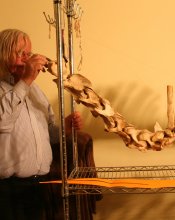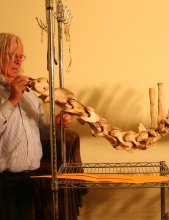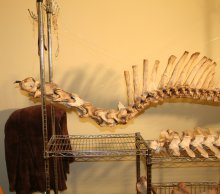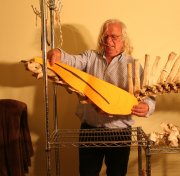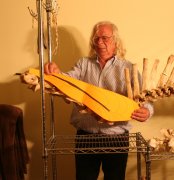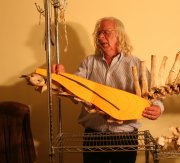Misconceptions About Long and Low
Misconceptions About Long and Low
First misconception, The neck became longer.
There are seven cervical vertebrae linked in an S shape. Vertebrae are bones. Their linkage can change shape but the structure cannot become longer. I can move the cervical vertebrae up and down and the structure does not became longer. The semispinalis capitis covers the entire cervical column. The muscles cover the length of the cervical column. The S shape can change, giving a rounder shape or longer shape to the neck but the length of the cervical vertebrae and associated muscles does not change much.
For example, I can place the cervical vertebrae in different position, up, not so up or longer, the absolute length of the cervical vertebrae does not change. (click images to enlarge)
If I place the smispinalis capitis as it is inside the neck, I can freeze the cervical column in different positions, higher or lower and the muscle follows the movement but does not elongate. 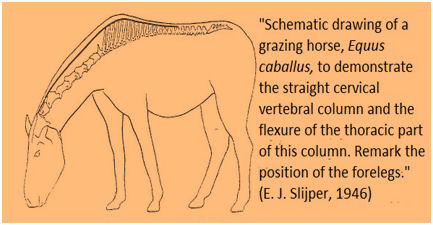 It would a little if the cervical vertebrae, instead of sustaining a S shape were extended to a fully straight position. This can happen when the horse is grazing. In 1915, Virchow explained that, “In the dorsal direction, the cervical vertebral column can be stretched only so far, that the vertebrae are lying in a straight line.” On the diagram, the black line illustrates the nuchal and supraspinous ligament.
It would a little if the cervical vertebrae, instead of sustaining a S shape were extended to a fully straight position. This can happen when the horse is grazing. In 1915, Virchow explained that, “In the dorsal direction, the cervical vertebral column can be stretched only so far, that the vertebrae are lying in a straight line.” On the diagram, the black line illustrates the nuchal and supraspinous ligament.
To do so, the horse lowers the trunk between the forelegs increasing the weight on the forelegs. In the western pleasure world, some horses carry their head that low and the load on the forelegs is so heavy that they can no longer trot. The gait is totally deteriorated. The solution of the western world has not been questioning the damages of lowering the neck. Instead, they gave a new name to the gait.
On this picture, the structures involved are the nuchal ligament, the semispinalis capitis and the splenius. 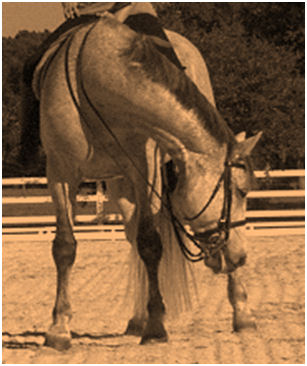 The nuchal ligament is not at its limit of elastic compliance but is under strain. The nuchal ligament is therefore the structure carrying more loads. The senispinalis capitis of both side are resisting attraction of gravity. The neck position is possible because the compartments of the semispinalis capitis permit all type of different neck posture. The splenius are the muscles creating lateral bending. They resist attraction of gravity and contract on the left side creating left lateral bending.
The nuchal ligament is not at its limit of elastic compliance but is under strain. The nuchal ligament is therefore the structure carrying more loads. The senispinalis capitis of both side are resisting attraction of gravity. The neck position is possible because the compartments of the semispinalis capitis permit all type of different neck posture. The splenius are the muscles creating lateral bending. They resist attraction of gravity and contract on the left side creating left lateral bending.
If there is an elongation of the semispinalis capitis due to the combination between lowering and lateral bending, it is the internal tendon that elongates. The elements of the semispinalis capitis situated above the internal tendon contracts in order to increase the resistance of the internal tendon. The segments of the semispinalis capitis situated below the internal tendon will contract when the horse will decide raising the neck.
Just for your eye education, you may observe the inverted rotation of the thoracic spine caused by the lateral bending of the neck. The horse shifts his weight on the right foreleg.
Theories associating muscles elongation with lowering of the neck theorizes a muscular work that does not exist. This picture shows the funicular and lamellar elements of the nuchal ligament. Peoples who want to believe that the lowering of the neck does stretch the upper neck muscles will theorize that the upper neck muscles are set and working in
in the direction of the black arrow. In reality, they are set in the direction of the red arrow and they are resisting attraction of gravity. 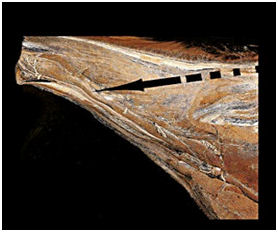
The neck can of course take a shorter shape such as the frame of this horse at the piaff. The S shape is different and the muscles work concentrically.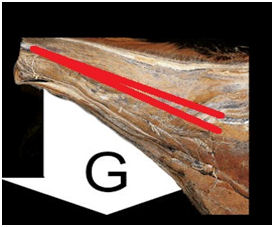 I let you evolve form the false idea that the neck became longer. You may have questions and they are welcome. Opinions based on other peoples’ opinion getting their source from other peoples’ opinion, without any scientific or even simply sound background are not welcome.
I let you evolve form the false idea that the neck became longer. You may have questions and they are welcome. Opinions based on other peoples’ opinion getting their source from other peoples’ opinion, without any scientific or even simply sound background are not welcome.
We will review next time another misconception that is promoted as the neck “reaching out” and the so called “telescopic” action of the neck. . 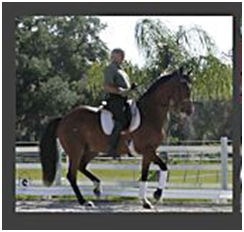
Jean Luc Cornille


